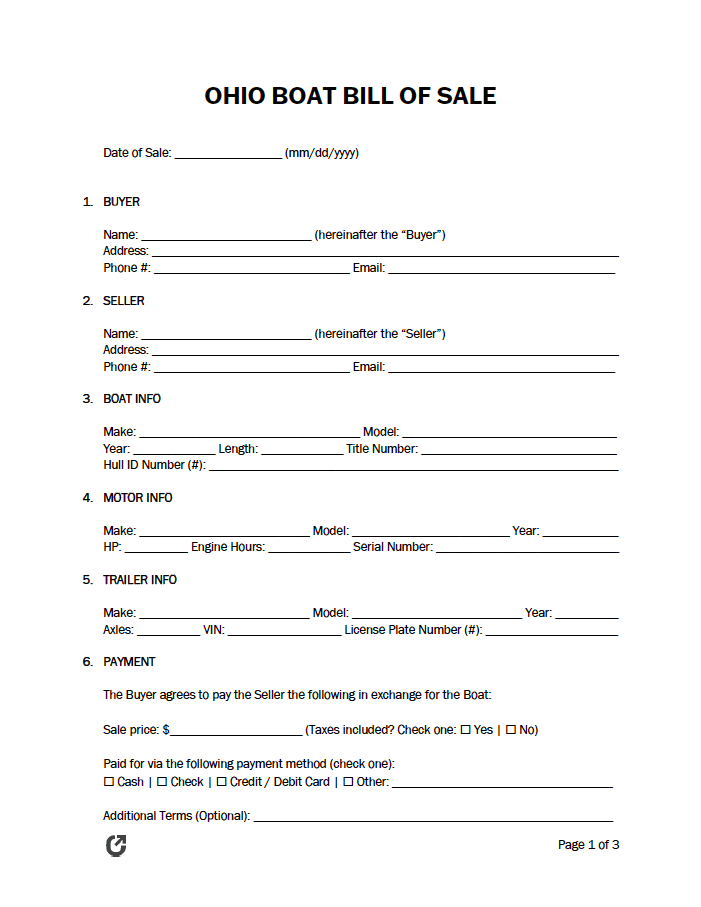Ohio Boat Bill of Sale Form
An Ohio boat bill of sale form is vital when transferring ownership of a watercraft. This legally binding agreement ensures a smooth transaction by detailing essential information such as buyer and seller’s names, boat specifications, and sale prices. The person completing the bill of sale must use accuracy and ensure both parties sign it. They must also submit to the proper authorities for registration and titling purposes to protect both parties and comply with state regulations.
|
What is an Ohio Vessel Bill of Sale?
An Ohio vessel bill of sale form is essential in establishing proof of ownership and preventing potential disputes. This document also assists in calculating the applicable taxes based on the transaction price. Moreover, it helps track the boat’s history, giving future buyers valuable information about previous ownership and possible maintenance issues. An accurate and complete document is crucial for a successful transaction. It also ensures the protection of both buyer and seller interests.
Did You Know?In Ohio, boaters need a license to operate watercraft on state waters. The state requires individuals born on or after January 1, 1982, to complete an approved boating safety course and obtain a boating education certificate. This boating license certificate allows individuals to operate motorized vessels legally. Ohio’s minimum age to acquire a boating education certificate is 12. However, those between 12 and 15 can use a boat only under the direct supervision of someone at least 18 with a valid boating education certificate. |
How to Register a Boat in Ohio (4 Steps)
In Ohio, boat owners must register a boat, as the state mandates both title and registration for most watercraft. Upon purchasing a new or used boat, residents must complete their application within thirty (30) days. Failure to obtain proper title and registration within this period may result in penalties and restrictions on operating the vessel. In Ohio, navigating waterways without a valid title and registration can lead to fines and potential legal consequences.
Step 1 – Exemptions
Certain boats are exempt from registration requirements in Ohio. These exemptions typically include the following:
- Boats that the U.S. Coast Guard documents as they follow federal procedures.
- Watercraft from other states or countries temporarily use Ohio waters for sixty (60) days or less.
- Vessels that government agencies own, such as federal, state, or local authorities.
- Boats that individuals propel solely by oars or paddles, including canoes, kayaks, and rowboats.
- Inflatable watercraft that are less than eight (8) feet in length.
- Vessels that are used exclusively as lifeboats on larger vessels.
These exemptions may be subject to change. Residents should consult the latest Ohio boating regulations or the Ohio Department of Natural Resources (ODNR) for up-to-date information.
Step 2 – Registration
Residents must follow a series of steps to register a boat in Ohio. First, the individual should obtain the necessary application forms, typically available online or at any Ohio Department of Natural Resources (ODNR) office. Next, they need to gather the required documentation, such as proof of ownership, a bill of sale, and, if applicable, the boat’s title.
After assembling the required documents, the applicant must complete the Certified Watercraft Registration Application (Form DNR 8460R). They must provide accurate information about the boat, including its make, model, year, hull identification number (HIN), and other relevant details. Additionally, they should calculate and include the applicable registration fees based on the boat’s size and type.
Finally, the boat owner must submit the completed application, supporting documents, and fees to the appropriate ODNR office by mail or in person. Once the application is processed and approved, the boat owner will receive their registration and decals, which they must display on the vessel according to Ohio regulations.
| Provide the Following: |
Step 3 – Numbers + Decal
After successfully registering and titling a boat in Ohio, the owner must correctly display the vessel’s assigned registration numbers and decals.
The registration numbers should be affixed on both sides of the bow, ensuring they are visible and legible. In Ohio, the numbers must be at least three (3) inches high, in block letters, and contrasting with the boat’s color. A hyphen or space equivalent to the width of a letter, excluding “I” or “1,” should separate the letter and number groupings.
The validation decals, indicating the registration’s expiration date, must be attached within six (6) inches of the registration number, either before or after the number. Adhering to these guidelines ensures compliance with Ohio boating regulations and promotes water safety.
Step 4 – Renew
Owners must renew their boat’s registration every three (3) years; they expire on March 1st of the year. Before the expiration date, the Ohio Department of Natural Resources (ODNR) usually sends out a renewal notice, making it easier to remember the deadline. The boat owner can renew the registration through several methods.
One option is to renew online by visiting the ODNR website. The owner must have their personal identification number (PIN) to complete this process, which they can find on their renewal notice. They must also provide the boat’s registration number and pay the required fees using a credit card. Online renewal can occur between January 1st and October 31st of any given year.
Alternatively, the owner can renew the registration by visiting a local ODNR office or an authorized deputy registrar. In this case, they must bring the completed renewal form and pay the necessary fees. Once the renewal process is complete, the owner will receive updated validation decals to display on their vessel, per Ohio boating regulations.
